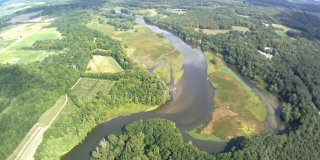Nutrient Management
While there has been progress toward reducing nutrient pollution nationwide, it is still a challenge to consider the appropriate spatial and temporal context for comprehensive strategies to meet nutrient reduction goals. EPA is providing research that develops, informs, and evaluates nutrient reduction strategies. In addition, EPA is taking a cross-disciplinary approach to the science, engineering, economics, and stakeholder engagement related to nutrient management to provide whole-system tools and techniques.
Nutrient Reduction
EPA is applying state-of-the-science nutrient management to provide methods, models, and prediction tools to help design, track, and evaluate nutrient reduction activities at watershed scales. Examples of this research include the following:
- A modeling system to assess how atmospheric deposition and a changing climate contribute to the total nitrogen load and its impacts on large river basins.
- A toolbox for nutrient pollution source tracking, including the application of isotopic tracers and indicators to help pinpoint specific reasons for nitrate changes in agricultural well water.
- An evaluation of changes in landscape sources of nutrient loadings to U.S. waters using results from the National Aquatic Resource Surveys.
- Use of national nitrogen and phosphorus input inventories to assess effectiveness of restoration and conservation practices for water quality.
- Evaluation of river floodplain restoration approaches’ effects on water quality and watershed-scale evaluation of best management practices (BMP) for nutrient reduction.
Tools and techniques from this research help plan, implement, and track the effectiveness of nutrient reduction strategies at multiple spatial and temporal scales, including watersheds draining to receiving waters potentially affected by HABs or other nutrient-related water quality impairments.
Collaborative Research Approaches
Nutrient reduction requires participation of a range of stakeholders to consider the economic, environmental, agricultural, and community perspectives. EPA research works with these groups to provide a means of considering non-traditional participants in nutrient reduction. This whole-system approach to nutrient reduction research includes the following:
- Economic and water quality feasibility analysis to compare costs for non-traditional participants in market mechanisms.
- A collaborative community-driven research project with farmers, crop advisers, state agencies and other stakeholders to provide approaches and lessons learned for addressing water quality goals.
- Solutions-driven research pilot that will field test new and enhanced low-nitrogen septic system designs and resulting changes in groundwater nitrogen levels as well as a woodchip-based bioreactor for denitrifying the water within ditches of the Hamblin Cranberry Bog.
Nutrient Restoration and Recovery

Excess nutrients are major stressors on stream and river ecosystems globally. Despite general acceptance of nutrient pollution as a problem, effective restoration and recovery are limited by understanding of the ways in which diverse aquatic ecosystems and biological communities respond to nutrients and related stressors. EPA’s nutrient restoration and recovery research generates scientific information, data, models, and tools that describe and quantify aquatic ecosystem responses to nutrient pollution, as well as the processes and time to recover from nutrient pollution impacts.
This research includes the following:
- Assessment of the responses of freshwater and coastal ecosystems to nutrients and related stressors (e.g., nuisance algae, hypoxia, acidification) and the processes and trajectories associated with recovery from those stressors.
- Development and data, models, and tools to identify watersheds and water bodies that may most effectively respond to restoration and recovery efforts.

EPA researchers are also working on methods for recycling resources rather than only treating waste products. For example, the high levels of nitrogen and phosphorus in wastewater could be used as nutrient resources for farming instead of ending up in water bodies that may already be overloaded with these nutrients.
Research is being conducted to develop new technologies that will increase the effectiveness of resource recovery for nitrogen and phosphorus in water systems . Studies are also being conducted to demonstrate nutrient recovery options in order to test, assess, and better understand recovery technologies.
Nutrient Management Case Studies
Narragansett Bay Nitrogen
A case study involving an integrated and sustainable research and management approach is focusing on Narragansett Bay in Rhode Island, including its watershed and air shed. Researchers are investigating how changes in nitrogen release into water bodies and climate impact watersheds and water quality. The research will be used to help restore and protect watersheds and highly valued water resources. Researchers are
- Investigating how nitrogen from different sources interacts with other pollutants (such as phosphorus, sulfur, and mercury) and affects lakes and reservoirs.
- Analyzing variations in nitrogen and phosphorus fluxes through the watershed to Narragansett Bay and how nutrient management decisions have impacted ecosystem structure, function and health in the watershed and estuary.
- Developing computational tools for more informed nutrient management, and contributing to the scientific basis for comprehensive ecosystem-based management plans designed to help restore and sustain our valued water resources.
The management approaches and computational tools developed based on this research will be adaptable for use in other threatened water systems across the country.
- Narragansett Bay Sustainability Pilot Phase I Report (pdf) (EPA funded study completed by Industrial Economics, Inc.)
- Narragansett Bay Sustainability Pilot, Appendices (pdf) (EPA funded study completed by Industrial Economics, Inc.)
- EPA’s Triple Value Simulation Model (pdf). The Triple Value Simulation (3VS) is a high-level model that accounts for the complex relationships among economic, social and environmental systems in order to explore scenarios and solutions to improve the health of the Bay.
Gulf of Mexico Hypoxia
Hypoxia is a condition of low oxygen in the water than can kill fish and other aquatic animals. The world’s second largest hypoxic zone is located in the northern Gulf of Mexico, which is referred to as the Dead Zone. The main cause of hypoxia in the Gulf is high levels of nitrogen and phosphorus that are discharged by waters from the Mississippi River Basin.
EPA researchers are developing state-of-the-art 3-D water flow and water quality models of the northern Gulf of Mexico Dead Zone as well as the Mississippi River Basin. The research is being done to understand the multiple nutrient sources, nutrient movement patterns, and impacts along the freshwater Basin and through to the Gulf’s marine environment.
The models can be used to better understand how potential nutrient management and climate change scenarios will affect the northern Gulf hypoxic area and water quality throughout the Mississippi River Basin.
Yakima River Basin
EPA and US Geological Survey researchers are working together to identify sources and impacts of nitrogen in the lower Yakima River Basin, a local source of drinking water. Using USGS and EPA data and models, researchers are working to pinpoint the major sources of nitrogen pollution and track its movement through groundwater in the Basin.
With this information, local leaders can improve groundwater quality by better understanding how nitrogen pollution affects drinking water supplies.
Guánica Bay
The multi-Agency U.S. Coral Reef Task Force initiated a program to address sediment and nutrient pollution of coral reefs in the Puerto Rico’s Guánica Bay watershed.
Municipal and agricultural growth in the Guánica Bay watershed has improved socioeconomic conditions, but also has reduced forest cover, impacted the quality and availability of drinking water and increased sediment and nutrient runoff. This runoff has adversely affected coastal sea grasses, mangroves and coral reefs. Research is providing information on the costs and benefits of using environmental resources and identifying options for supporting sustainability in the Bay.
Iowa
EPA is working with the U.S. Geological Survey and the state of Iowa to develop methods for lowering sediment and nutrient pollution in surface waters draining into the Mississippi River Basin. The results of this research will help protect and restore watersheds and improve water quality throughout the entire Midwest.
Related Research
- Nutrients
- Water Quality Impacts of Nutrients
- Harmful Algal Bloom and Cyanobacteria
- Reducing Excess Nutrients Research Pilot

